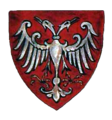 Double-headed eagle of Nemanjić dynasty Double-headed eagle of Nemanjić dynasty | |
| Heraldic tradition | Byzantine |
|---|---|
| Governing body | Serbian Heraldry Society |
Serbian heraldry involves the study and use of coats of arms and other heraldic insignia in the country of Serbia or by Serbs. The Serbian government is the armiger in Serbia, exercising that right under the advice of the Serbian Heraldry Society (Serbian Cyrillic: Српско хералдичко друштво, romanized: Srpsko heraldičko društvo), a learned society devoted to the study and creation of heraldry, specifically Serbian heraldry.
Serbian heraldry in large part belongs to the Byzantine tradition. Serbian nobility in the Habsburg monarchy, upon receiving noble status, adopted coat of arms often influenced by the Illyrian Armorials.
Common symbols
See also: Serbian eagle and Serbian crossThe most prominent and common symbols are the Serbian eagle (as in some other European heraldic traditions, the most prominent among the animals) and the Serbian cross, representing the national identity of the Serbian people across the centuries. Another common symbol is the Triballian boar, depicting the head of a boar pierced by an arrow. It was used for historical Serbia in numerous armorials dating between the 15th and 18th centuries and was incorporated into the seal of the government of the Revolutionary Serbia.
-
 Serbian eagle as seen in a modern stylized coat of arms of the Nemanjić dynasty
Serbian eagle as seen in a modern stylized coat of arms of the Nemanjić dynasty
-
 Serbian cross as seen in the "shield" of the coat of arms of Serbia
Serbian cross as seen in the "shield" of the coat of arms of Serbia
-
 Triballian boar as seen in the coat of arms of Kragujevac
Triballian boar as seen in the coat of arms of Kragujevac
Popular elements in modern Serbian heraldry include the Serbian tricolour, nature (such as oak, olive, wheat, plum, grape), and weapons (such as sword, cannon, gun, arrows). The severed Turk head, in reference to the wars with the Ottoman Empire, is used on the coat of arms of Kikinda and Vršac.
Coat of arms of Serbia
Main article: Coat of arms of Serbia
The modern coat of arms is derived from the Obrenović dynasty coat of arms, which drew influence from the medieval Nemanjić dynasty. The principal field stands for the Serbian state. It consists of a double-headed (bicephalic) eagle on a red shield; its body and wings in silver, and tongues, beaks, legs and claws in gold, between two golden fleurs-de-lys. The inescutcheon stands for the Serbian nation; in a red shield, a cross between four silver firesteels arranged in the quarters around it, all of them facing horizontally outwards. The coat of arms also features the Serbian historical crown; while unusual for republics, it is not unprecedented, as can be seen in coat of arms of numerous European countries with republican form of government (Russia, Poland, Romania, Hungary, Bulgaria, Montenegro, and San Marino). The coat of arms is used in the form of the Greater coat of arms and Lesser coat of arms, as provided by the Article 7 of the Constitution of Serbia.
Coat of arms of municipalities and cities in Serbia
Main article: Armorial of Serbia|
|
|
See also
References
- ^ Atlagić 2009, p. 180.
- Vanja Kraut; Miodrag Đorđević; Rade Rančić (1985). Istorija srpske grafike od XV do XX veka. Narodni muzej. p. 73. ISBN 9788636700013.
- SANU (1957). Posebna izdanja. SANU. p. 130.
Further reading
- Acović, Dragomir (2012) . Heraldika i Srbi. Zavod za udžbenike. ISBN 978-86-17-15093-6.
- Atlagić, Marko (1997). "The cross with symbols S as heraldic symbols" (PDF). Baština. 8: 149–158. Archived from the original (PDF) on 21 May 2013.
- Atlagić, Marko (2007). "Печати Карађорђеви и његових првака у Првом српском устанку" (PDF). Зборник радова Филозофског факултета. 37. Филозофски факултет у Приштини.
- Atlagić, Marko (2009). "Određivanje nacionalnih heraldičkih simbola na primjeru Srba i Hrvata" [Étude des symboles nationaux héraldiques à l' exemple des Serbes et des Croates] (PDF). Zbornik radova Filozofskog fakulteta u Prištini. 39: 179–188.
- Ivanišević, Vujadin (2004). "Razvoj heraldike u srednjovekovnoj Srbiji" [The development of heraldry in medieval Serbia] (PDF). Zbornik radova Vizantološkog instituta. 41 (41): 213–234. doi:10.2298/ZRVI0441213I.
- Ivanišević, Vujadin (2001). Новчарство средњовековне Србије. Belgrade: Стубови културе. OCLC 54972050.
- Ivić, Aleksa (1910). Stari srpski pečati i grbovi: prilog srpskoj sfragistici i heraldici. Natošević.
- Ivić, Aleksa; Mrđenović, Dušan; Spasić, Dušan; Palavestra, Aleksandar (1987). Rodoslovne tablice i grbovi srpskih dinastija i vlastele. Belgrade: Nova knjiga. ISBN 9788673350509.
- Milićević, Milić (1995). Grb Srbije: razvoj kroz istoriju. Službeni glasnik. ISBN 9788675490470.
- Novaković, Stojan (1884). "Хералдички обичаји у Срба: у примени и књижевности". Београд: Краљевско-српска државна штампарија. Archived from the original on 22 April 2015.
- Odak, Marina I. (2015). "Ikonografija i simbolika predstava na srpskom srednjovekovnom novcu". Belgrade: Filozofski fakultet.
- Palavestra, Aleksandar (June 1998). "O ocilima" (PDF). Glasnik SHD (in Serbian). Archived from the original (PDF) on 29 October 2013.
- Palavestra, Aleksandar (2010). Ilirski grbovnici i drugi heraldički radovi. Belgrade: Dosije studio.
- Solovjev, Aleksandar Vasiljevič (1958). Istorija srpskog grba. Srpska misao.
- Stanojević, Stanoje (1934). "O srpskom grbu". Iz naše prošlosti. Belgrade: Geca Kon A. D. pp. 85–90.
- Pavlović, Milijvoje (2007). "Grbovi starog i novog doba". Srpska znanja: zvuci, boje, oblici. Belgrade: Čigoja. pp. 15–23.
External links
| Heraldic traditions by country | |
|---|---|
| Africa | |
| Americas | |
| Asia | |
| Europe | |
| Oceania | |